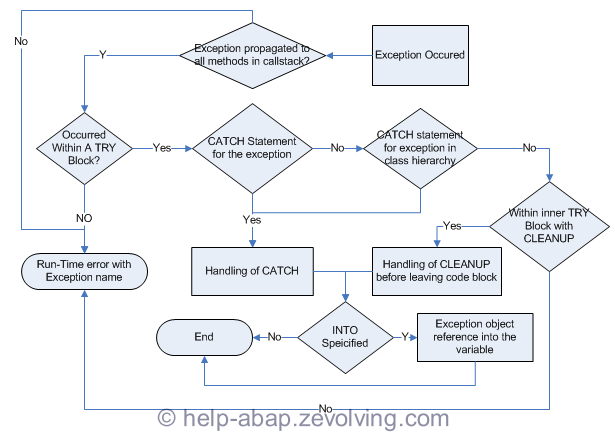Lets continue exploring more about Class based exceptions by checking out the runtime flow when an exception is being raised.
Checkout all post related to Exception Raising & handling:
- Function Module Exception Handling
- Raising & Handling Non-class based exceptions – I
- Raising & Handling Non-class based exceptions – II
- Class-based Exceptions I – Basics
- Class-based Exceptions II – Design Time consideration
- Class based Exceptions III – Runtime flow
- Class based Exceptions IV – CLEANUP
- Exception class to use Messages from T100
- Why NOT to have a wrapper around Exception (RAISE) ?
Flow

.. with code lines
To understand it better we’ll use the demo example of Class-based Exceptions I – Basics. I have given the related code snippets here. It would be useful to compare both of the code snippets to understand, how system is behaving.
- If raised exception is not being propagated in the call stack for (CX_STATIC_CHECK & CX_DYNAMIC_CHECK exceptions) till a TRY..ENDTRY block, it would result into Runtime error. Like in Demo, if the LCX_MANDATORY_MISSING was not specified in the method CALCULATE, it would result in run-time error.
- In case of exception, system would try to find corresponding TRY .. ENDTRY block in the call hierarchy. If it doesn’t find any, it would result in Short-dump. Like in the demo, if the method CALCULATE would be called directly without TRY..ENDTRY it would result in short dump.
- If a TRY..ENDTRY block with specific exception being caught using CATCH excpetion_id, system would be successfully able to handle the exception. Whenever INTO addition is specified, instance of an exception object would be generated. In demo application, exception LCX_MANDATORY_MISSING is an example.
- If a TRY..ENDTRY block with generic exception being caught using CATCH exception_id, exception would be handled successfully. In demo, exception CX_ROOT is handled this way. This code lines will raise CX_SY_ZERO_DIVIDE, but CX_ROOT is being handled.
- If a CLENUP block is specified, within an inner block of TRY…ENDTRY, it would gets executed, before sending control back to the caller. More on CLEANUP in coming post.
Missing exception declaration
* CLASS lcl_test_exceptions DEFINITION. PUBLIC SECTION. METHODS: calculate IMPORTING iv_num1 TYPE i OPTIONAL iv_num2 TYPE i OPTIONAL RETURNING VALUE(rv_calc) TYPE i RAISING "lcx_mandatory_missing --- Commented - result in dump cx_sy_arithmetic_error.
Without TRY block
* Runtime error .. as TRY..ENDTRY commented CREATE OBJECT lo_obj. * TRY . lo_obj->calculate( iv_num1 = 10 ). * CATCH lcx_mandatory_missing. * WRITE: / 'Mandatory Parameter is missing'. * CATCH CX_ROOT INTO lo_exc_root. * lv_msg = lo_exc_root->get_text( ). * WRITE: / lv_msg. * ENDTRY.
Exact exception handler
TRY . lo_obj->calculate( iv_num1 = 10 ). * Exception is handled with itself CATCH lcx_mandatory_missing. WRITE: / 'Mandatory Parameter is missing'. ENDTRY.
Exception handling using super class
TRY . * Passed IV_NUM2 as 0 to get an exception lo_obj->calculate( iv_num1 = 10 iv_num2 = 0 ). * Exception is handled with itself CATCH CX_ROOT INTO lo_exc_root. lv_msg = lo_exc_root->get_text( ). WRITE: / lv_msg. ENDTRY.
Further Reading
Checkout all post related to Exception Raising & handling:
- Function Module Exception Handling
- Raising & Handling Non-class based exceptions – I
- Raising & Handling Non-class based exceptions – II
- Class-based Exceptions I – Basics
- Class-based Exceptions II – Design Time consideration
- Class based Exceptions III – Runtime flow
- Class based Exceptions IV – CLEANUP
- Exception class to use Messages from T100
- Why NOT to have a wrapper around Exception (RAISE) ?
[…] – II Class-based Exceptions I – Basics Class-based Exceptions II – Design Time consideration Class based Exceptions III – Runtime flow Class based Exceptions IV – […]